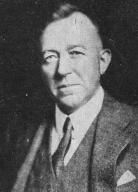Colpitts' began his education at Mount Allison University and was a teacher and school principal in Newfoundland. In 1895 he entered Harvard University where he studied physics and mathematics. He received a BA in 1896 and a Master's degree in 1897 from that institution. He remained at Harvard for two additional years. In 1899, Colpitts accepted a position with American Bell Telephone Company and moved to Western Electric in 1907. He patented his "Oscillation Generator" in 1920. Colpitts wrote that "the possibility of communication by speech between any two individuals in the civilized world is one of the most desirable ends for which engineering can strive."
Colpitts served in the US Army Signal Corps during World War I and spent some time in France as a staff officer involved with military communication.
In 1940, Colpitts was called out of retirement to head a committee reviewing the state of sonar development in the United States Navy. The committee report identified critical limitations of American sonar compared with German developments, which spurred American fundamental sonar research.
He was awarded the Elliott Cresson Medal in 1948.
Colpitts' began his education at Mount Allison University and was a teacher and school principal in Newfoundland. In 1895 he entered Harvard University where he studied physics and mathematics. He received a BA in 1896 and a Master's degree in 1897 from that institution. He remained at Harvard for two additional years. In 1899, Colpitts accepted a position with American Bell Telephone Company and moved to Western Electric in 1907. He patented his "Oscillation Generator" in 1920. Colpitts wrote that "the possibility of communication by speech between any two individuals in the civilized world is one of the most desirable ends for which engineering can strive."
Colpitts served in the US Army Signal Corps during World War I and spent some time in France as a staff officer involved with military communication.
In 1940, Colpitts was called out of retirement to head a committee reviewing the state of sonar development in the United States Navy. The committee report identified critical limitations of American sonar compared with German developments, which spurred American fundamental sonar research.
He was awarded the Elliott Cresson Medal in 1948.
Family Members
Sponsored by Ancestry
Advertisement
Advertisement















